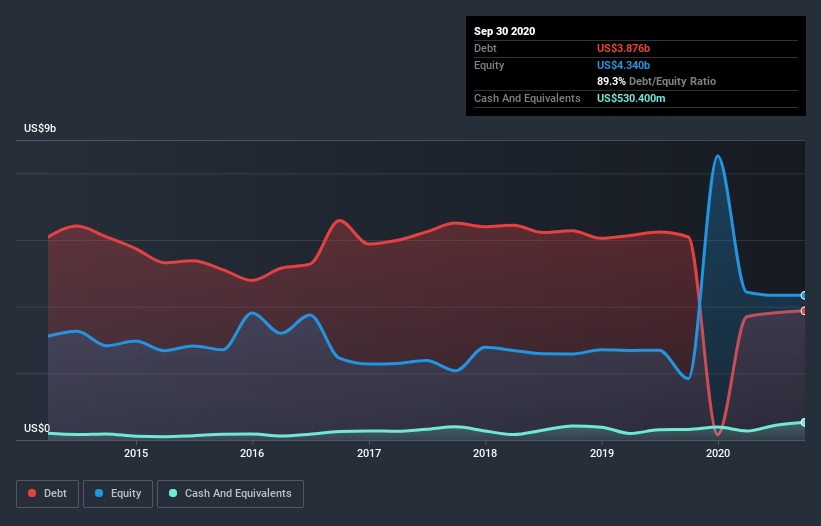Here's Why Molson Coors Canada (TSE:TPX.B) Is Weighed Down By Its Debt Load

Some say volatility, rather than debt, is the best way to think about risk as an investor, but Warren Buffett famously said that 'Volatility is far from synonymous with risk.' It's only natural to consider a company's balance sheet when you examine how risky it is, since debt is often involved when a business collapses. As with many other companies Molson Coors Canada Inc. (TSE:TPX.B) makes use of debt. But the more important question is: how much risk is that debt creating?
When Is Debt A Problem?
Debt is a tool to help businesses grow, but if a business is incapable of paying off its lenders, then it exists at their mercy. Part and parcel of capitalism is the process of 'creative destruction' where failed businesses are mercilessly liquidated by their bankers. However, a more usual (but still expensive) situation is where a company must dilute shareholders at a cheap share price simply to get debt under control. Of course, debt can be an important tool in businesses, particularly capital heavy businesses. When we examine debt levels, we first consider both cash and debt levels, together.
See our latest analysis for Molson Coors Canada
How Much Debt Does Molson Coors Canada Carry?
You can click the graphic below for the historical numbers, but it shows that Molson Coors Canada had US$3.88b of debt in September 2020, down from US$6.09b, one year before. However, it does have US$530.4m in cash offsetting this, leading to net debt of about US$3.35b.

How Strong Is Molson Coors Canada's Balance Sheet?
Zooming in on the latest balance sheet data, we can see that Molson Coors Canada had liabilities of US$1.42b due within 12 months and liabilities of US$4.72b due beyond that. On the other hand, it had cash of US$530.4m and US$455.0m worth of receivables due within a year. So its liabilities total US$5.15b more than the combination of its cash and short-term receivables.
This deficit casts a shadow over the US$735.0m company, like a colossus towering over mere mortals. So we'd watch its balance sheet closely, without a doubt. After all, Molson Coors Canada would likely require a major re-capitalisation if it had to pay its creditors today.
We measure a company's debt load relative to its earnings power by looking at its net debt divided by its earnings before interest, tax, depreciation, and amortization (EBITDA) and by calculating how easily its earnings before interest and tax (EBIT) cover its interest expense (interest cover). This way, we consider both the absolute quantum of the debt, as well as the interest rates paid on it.
Molson Coors Canada shareholders face the double whammy of a high net debt to EBITDA ratio (14.4), and fairly weak interest coverage, since EBIT is just 0.17 times the interest expense. This means we'd consider it to have a heavy debt load. Even worse, Molson Coors Canada saw its EBIT tank 81% over the last 12 months. If earnings continue to follow that trajectory, paying off that debt load will be harder than convincing us to run a marathon in the rain. The balance sheet is clearly the area to focus on when you are analysing debt. But you can't view debt in total isolation; since Molson Coors Canada will need earnings to service that debt. So if you're keen to discover more about its earnings, it might be worth checking out this graph of its long term earnings trend.
Finally, while the tax-man may adore accounting profits, lenders only accept cold hard cash. So the logical step is to look at the proportion of that EBIT that is matched by actual free cash flow. Over the last three years, Molson Coors Canada actually produced more free cash flow than EBIT. There's nothing better than incoming cash when it comes to staying in your lenders' good graces.
Our View
On the face of it, Molson Coors Canada's EBIT growth rate left us tentative about the stock, and its level of total liabilities was no more enticing than the one empty restaurant on the busiest night of the year. But on the bright side, its conversion of EBIT to free cash flow is a good sign, and makes us more optimistic. Taking into account all the aforementioned factors, it looks like Molson Coors Canada has too much debt. That sort of riskiness is ok for some, but it certainly doesn't float our boat. The balance sheet is clearly the area to focus on when you are analysing debt. However, not all investment risk resides within the balance sheet - far from it. Be aware that Molson Coors Canada is showing 2 warning signs in our investment analysis , and 1 of those is potentially serious...
If, after all that, you're more interested in a fast growing company with a rock-solid balance sheet, then check out our list of net cash growth stocks without delay.
If you decide to trade Molson Coors Canada, use the lowest-cost* platform that is rated #1 Overall by Barron’s, Interactive Brokers. Trade stocks, options, futures, forex, bonds and funds on 135 markets, all from a single integrated account. Promoted
New: Manage All Your Stock Portfolios in One Place
We've created the ultimate portfolio companion for stock investors, and it's free.
• Connect an unlimited number of Portfolios and see your total in one currency
• Be alerted to new Warning Signs or Risks via email or mobile
• Track the Fair Value of your stocks
This article by Simply Wall St is general in nature. It does not constitute a recommendation to buy or sell any stock, and does not take account of your objectives, or your financial situation. We aim to bring you long-term focused analysis driven by fundamental data. Note that our analysis may not factor in the latest price-sensitive company announcements or qualitative material. Simply Wall St has no position in any stocks mentioned.
*Interactive Brokers Rated Lowest Cost Broker by StockBrokers.com Annual Online Review 2020
Have feedback on this article? Concerned about the content? Get in touch with us directly. Alternatively, email editorial-team (at) simplywallst.com.
About TSX:TPX.B
Molson Coors Canada
Molson Coors Canada Inc. brews, markets, sells, and distributes various beer brands in the Americas, Europe, the Middle East, Africa, and the Asia-Pacific.
Unattractive dividend payer very low.
Similar Companies
Market Insights
Community Narratives





